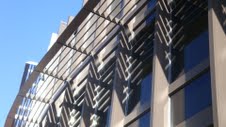At NOVA’s Annandale campus: A lesson in daring design
 By Elizabeth Kirchner
By Elizabeth Kirchner
The new student services building on the Annandale campus of Northern Virginia Community College (NOVA) is more than good architecture. It blends beauty and utility in an energy-smart, dual-flush, stormwater-absorbing reflection of the progressive ideals of the school’s faculty and staff.
In 2006, the building was already in its design phase when the College Senate’s Committee for Environmental Concerns (nicknamed the “Green Committee”) recommended that all new campus buildings meet energy efficient and environmentally sensitive LEED (Leadership in Energy and Environmental Design) standards.
“We wanted to not just build a building, but build the right kind of building,” recalls committee chair Ray Bailey. “The whole country is moving in a more sustainable direction, and our college intended to be a leader.” The president’s office welcomed the committee’s recommendation.

LEED-certified construction is estimated to use 30 percent less energy than conventional construction. To achieve LEED certification, a building must be energy-smart, environmentally sensitive, minimally invasive, and socially conscientious.
The new student services building on the Annandale campus is built on a tricky site on the southeast side of a steep hill, but a gently rising staircase takes students past terraced walls of local, honey-brown stone, native grasses, and stormwater-sopping rain gardens. Students can park their bikes in racks near busy café tables.
Above all that, metallic catwalk-slatted sunscreens [in photo above] curve along the south and west faces of the smoky glass tower—a bit of bling that also reduces interior heat while channeling natural light deep into glass-walled interior study rooms and offices.

Inside the building’s sliding double doors and air-quality controlling grilles, it’s full of light, air, and movement. Students are texting, chatting, and rushing to the testing center across sunlit pale blue recycled terrazzo. Busy as it is, the space seems hushed, calm, and full of light. A sweeping stairway leads to glass-walled study rooms, a Barnes and Noble, and a Starbucks.
“It’s glorious,” says a student counselor about her new office. “I was in an interior office in the old building. I never saw the sun.” She’s standing by her office window, where a view of the rain garden along the vast campus parking lot is shaded by a “light ledge” at transom height in the window, jutting about two feet into the room. The ledge is built to a depth determined by Annandale’s latitude to block the heat and glare of the sun when it’s high in the southern sky in the summer, while letting in sunlight when the sun is low in the south in the winter.
Although no actual data is yet available for the new building, Daniel Wells, NOVA’s director of capital projects says, “I can guarantee that it is using significantly less energy per square foot than any of our other buildings.” New construction and renovation projects planned for NOVA will all be designed to LEED Silver standards.
Fairfax County and the state of Virginia adopted ordinances requiring public buildings to meet LEED or LEED-like criteria two years after NOVA adopted its own green approach. “It’s not because of anything our school had undertaken,” Bailey says. “It’s just the right thing to do.”

